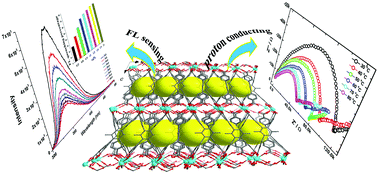A robust and multifunctional calcium coordination polymer as a selective fluorescent sensor for acetone and iron (+3) and as a tunable proton conductor†
Abstract
A multifunctional calcium coordination polymer (Ca-CP) formulated as [(CH3)2NH2][Ca(Me2tcpbH)(H2O)] (1) has been synthesized and characterized. Compound 1 features a robust and novel three-dimensional (3D) network with cage-like cavities. The high thermal and moisture stability of the title compound makes it a good candidate for possible environment or energy related applications. Fluorescence (FL) studies demonstrate that 1 shows emission with a maximum at 350 nm under 270 nm excitation. The title compound acts as a selective and sensitive fluorescent sensor for the detection of acetone and Fe3+ ions at low concentrations. The FL intensity quenching percentage and the concentration ratio of Fe3+/Fe2+ showed a linear relation with a Fe3+ concentration as low as 50 μM in Fe2+ aqueous solutions, offering an easy way to probe the extent of Fe2+ oxidation. Moreover, due to the relatively high hydration character of Ca2+, the terminal water molecules and undeprotonated carboxylate groups form a strong hydrogen-bonded network within the structure, facilitating its tunable proton conduction under various humidity and temperature conditions. The proton conducting mechanism has been investigated using PXRD, IR, and EA methods.



 Please wait while we load your content...
Please wait while we load your content...
